BUICK PARK AVENUE 1998 Owners Manual
Manufacturer: BUICK, Model Year: 1998, Model line: PARK AVENUE, Model: BUICK PARK AVENUE 1998Pages: 426, PDF Size: 23.59 MB
Page 91 of 426
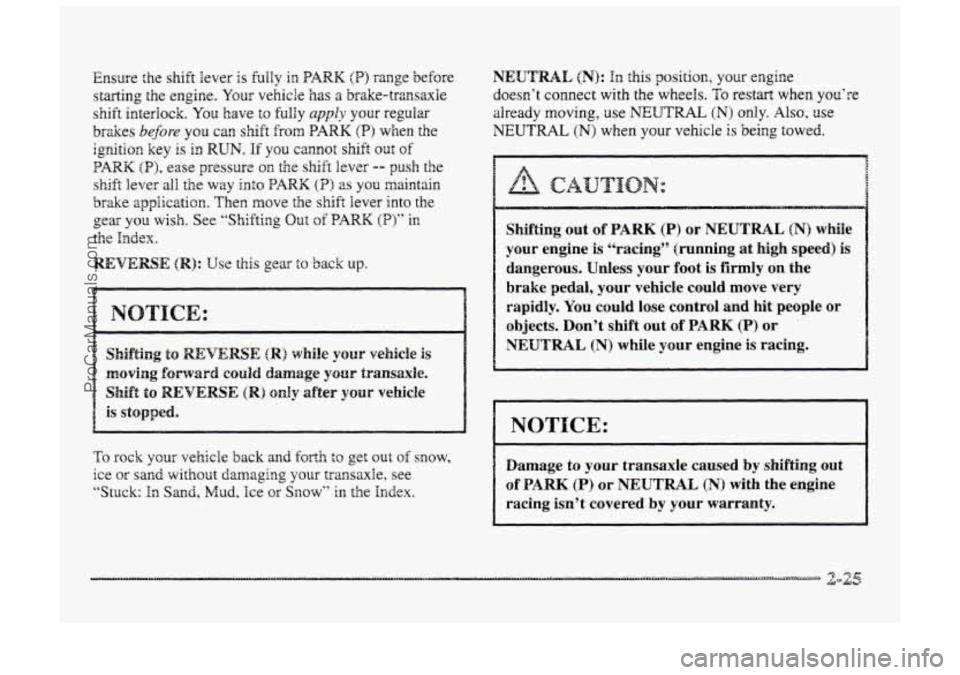
Ensure the shift lever is fuily in PARK (PI range before
starting the engine.
Your vehicle has a brake-transaxle
shift interlock.
You have to fully apply your regular
brzkes
before you can shift from PARK (P) when the
ignition key is in RUN. If you cannot shift out of
PARK (B), ease pressure on the shift lever -- push the
shift lever all the way into PARK (P) as you rnaintain
brake appiic~tion. Then move the shift lever into the
gear you wish. See “Shifting Out of PARK (E’)” in
the Index.
REVERSE (R): Use this gear to back up.
Shift to REVERSE (R) oanhy after vehicle
To rock your vehicle back and forth to get out of snow,
ice sand without damaging your transaxle, see
“Stuck:
In Sand, Mud, Ice or Snow” in the Index.
NEUTRAL (N): In this position, your engim
doesn’t connect with the wheels.
To restart when you’re
already
moving, use NEUTRAL (N) only. Also, use
NEUTRAL (N) when your vehicle is being towed.
Shifting out of PARK (P) or NEUTRAL fN) while
your engine is “racing” (running
at high speed) is
dangerous. Unless your foot is firmly on the
brake pedal, your vehicle could move very
rapidly. You could lose control and hit people
or
objects. Don’t shift out of PARK (P) or
NEUTRAL (N) while your engine is racing.
1 NOTICE:
Damage to your transaxle caused by shifting out
of PARK (P) or NEUTRAL (N) with the engine
racing isn’t covered by your warranty.
ProCarManuals.com
Page 92 of 426
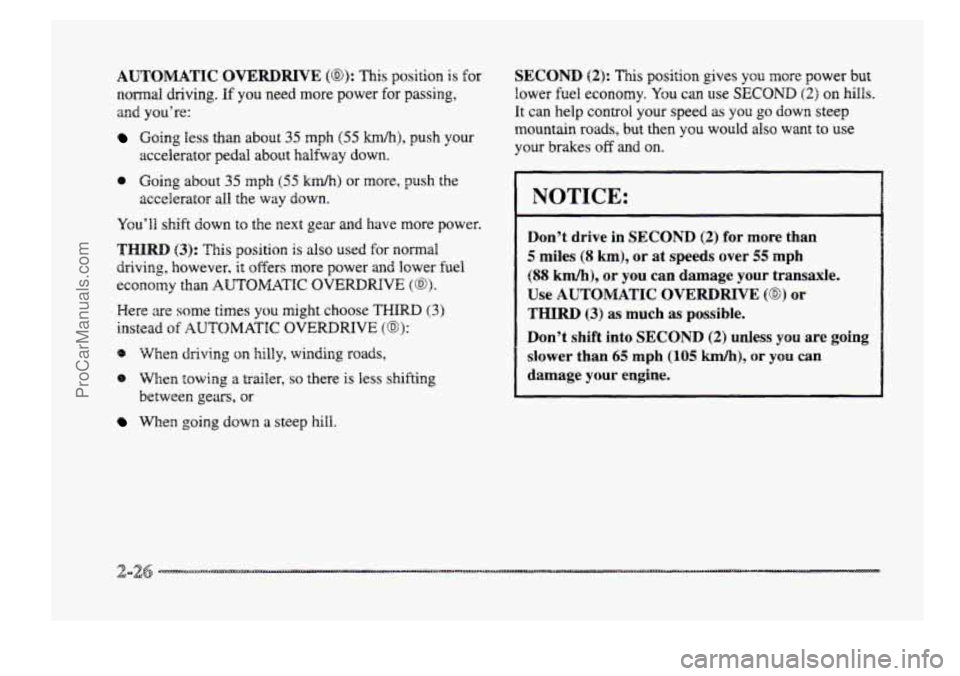
AUTOMATIC OVERDRIVE (@):This positionis for
normal driving. Pf you need more power for passing,
and you’re:
Going less than about 35 mph (55 kmh), push your
accelerator pedal about halfway down.
e Going about 35 mph (55 kmh) or more, push the
accelerator
all the way down.
You’U shift down to the next gear and have more power.
THIRD (3): This position is also used for normal
driving, however, it offers more power and Bower fuel
economy than AUTOMATIC OVERDRIVE (0).
Here are some times you might choose THIRD (3)
instead of AUTOMATIC OVERDRIVE (a):
Qb When towing a trailer, so there is less shifting
between gears,
or
SECQND (2): This position gives you nore power but
lower fuel economy. YQU can use SECOND (2) on hills.
It can help control your speed as you go down steep
mountain roads, but
then you would also want to use
your
brakes off and on.
NOTICE:
Don’t drive in SECOND (2) for more than
5 miles (8 km), or at speeds over 55 mph
(88 km/h), or you can damage your transaxle.
Use AUTOMATIC OVERDRIVE (0) or
THIRD (3) as much as possible.
Don’t shift into SECOND
(2) unless you are going
slower than
65 mph (105 km/h), or you can
damage your engine.
When going down a steep hill.
ProCarManuals.com
Page 93 of 426
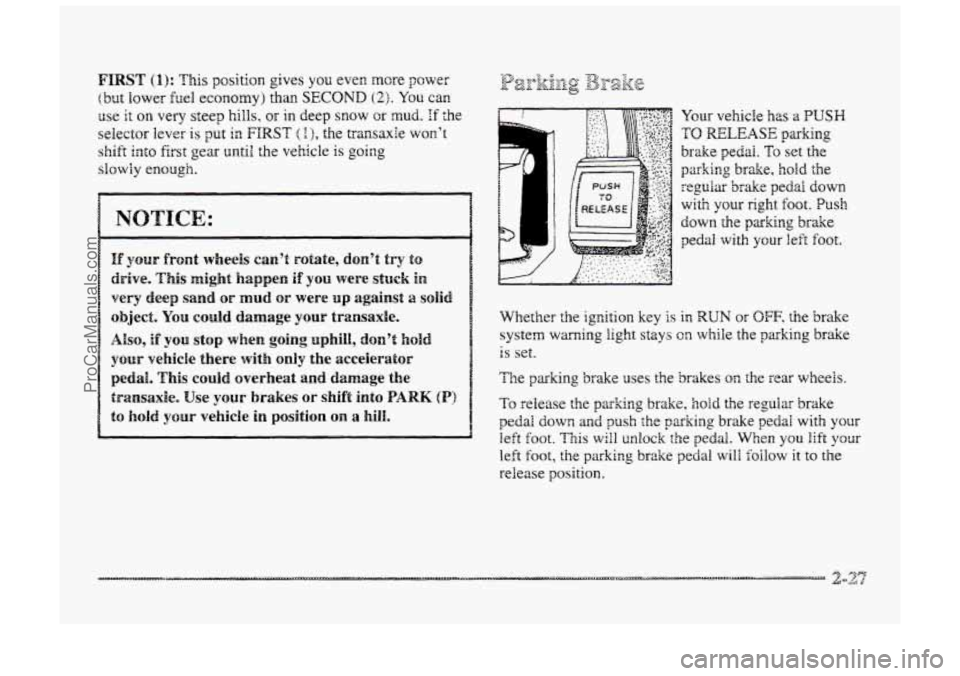
FIRST (I): This position gives you even more power
(but lower fuel economy) than SECOND (2). You can
use it on very steep hills, or in deep snow or mud. If the
selector lever is put in FIRST ( I >, the transaxle won’t
shift into first gear until the vehicle is going
slowHy enough.
If your hplrt wheels can’t rotate, don’t try to
drive. This might happen if YOU were stuck in
very deep sand OF mud or were up against a solid
object. You could damage your transaxle.
Also, if you stop when going uphill, don’t hold
your vehicIe there with only the accelerator
pedal. This could overheat and damage the
transaxle. Use ysur brakes or shift into BARK (P)
Your vehicle has a PUSH
TO RELEASE parking
brake pedai. To set the
parking brake, hold the
regular brake pedal down
with your right foot. Push
down the papking brake
pedal with your left foot.
~~ ~~
Whether the ignition key is in RUN or OFF. the brake
system
wming light stays on while the parking brake
1s set.
The parhng brake uses the brakes the rear wheels.
To release the parking brake, hoki the regular brake
pedal down and push the parking brake pedal with your
left foot. This will unlock the pedal. When you lift your
left foot, the parking brzke pedal will foilow it to the
release position.
ProCarManuals.com
Page 94 of 426
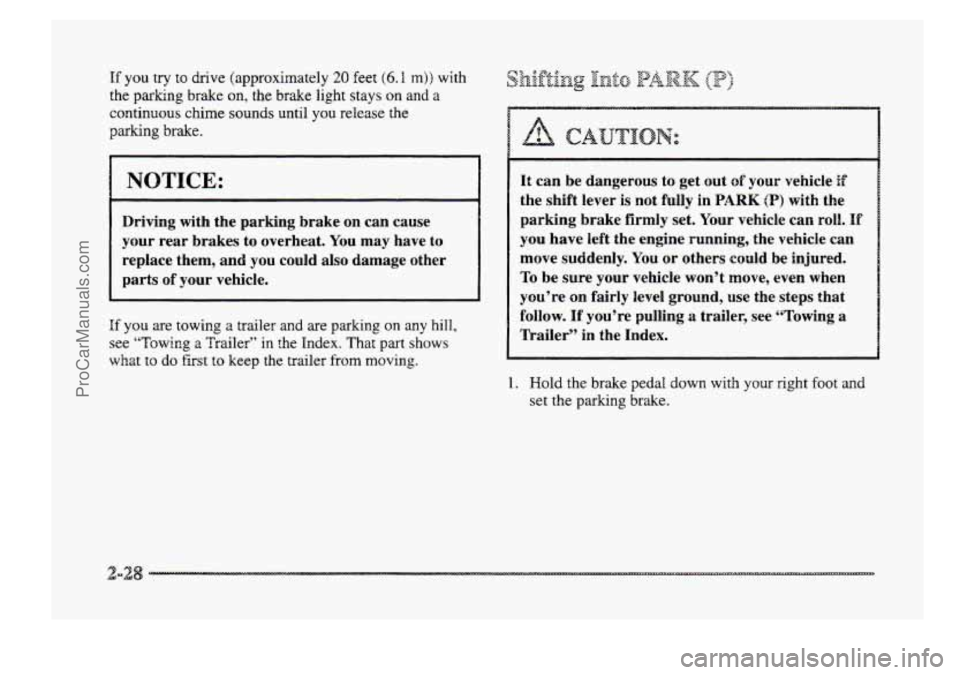
If you try to drive (approximately 20 feet (6.9 m)) with
the
parlkrng brake on, the brake light stays on and a
continuous chime sounds until you release the
parking
brake.
NOTICE:
Driving with the parking brake on can cause
your rear brakes to overheat. You may have to
replace them, and you could also damage other
parts
of your vehicle.
If you are towing a trailer and are parking on any hill,
see “Towing a Trailer” in the Index. That part shows
what
to do first to keep the trailer from moving.
It can be dangerous to get out of your vehicle if
the shift lever is not fully in PARK (P) with the
parking brake firmly set. Your vehicle can roll.
If
you have left the engine running, the vehicle can
move suddenly. You or others
could be injured.
To be sure your vehicle won’t move, even when
you’re on fairly level ground,
use the steps that
follow.
If you’re pulling a trailer, see “Towing a
Trailer” in the Index.
1. Hold the brake pedal down with your right foot and
set the parking brake.
ProCarManuals.com
Page 95 of 426
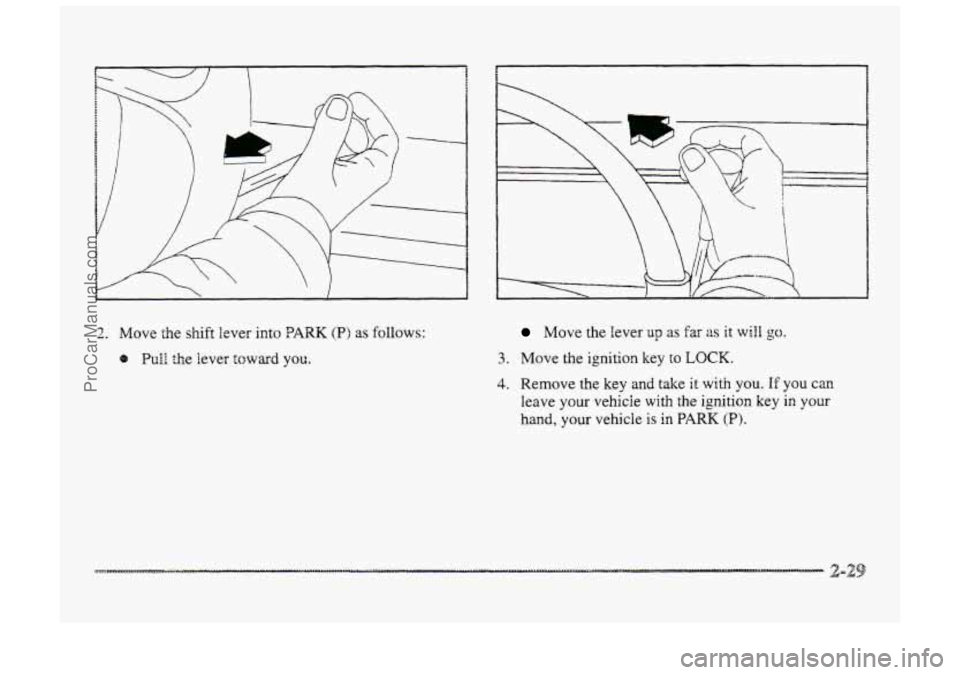
2. Move the shift lever into ?ARK (B) as follows:
8 Pull the iever toward you.
Move the lever up as far as it will go.
3. Move the ignition key to LOCK.
4. Remove the key and take it with you. If YOU can
leave
your vehicie with the ignition key in your
hand, your vehicle is in PARK (P).
ProCarManuals.com
Page 96 of 426
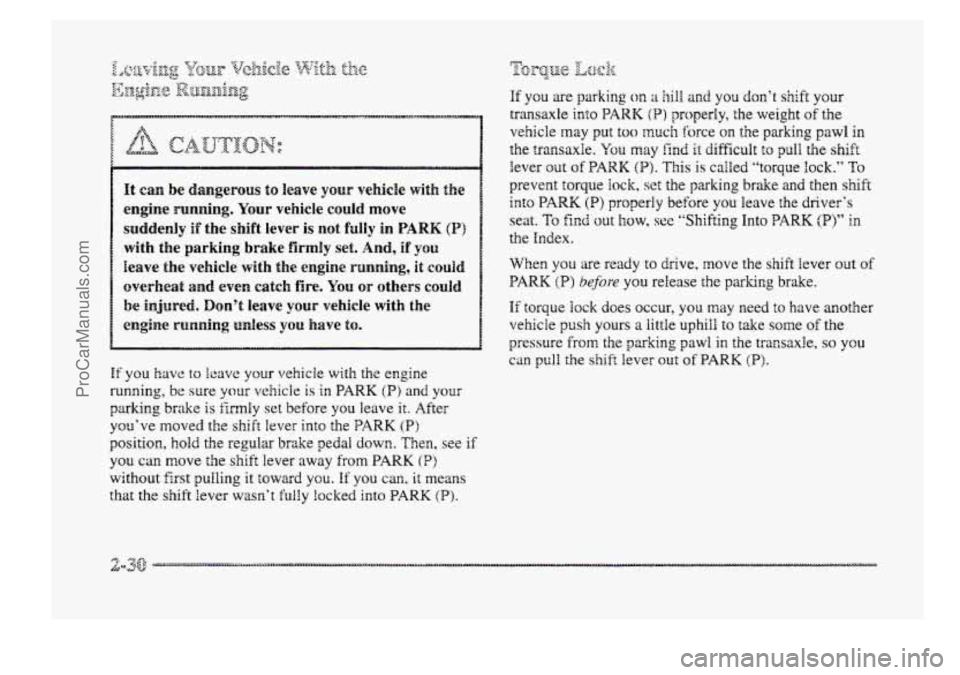
~ It can be dangerous to leave YQW vehicle with the
~ engine running. Your vehicle could move
i suddenly if the
shift lever is not hlPy in PARK (P)
with the parking brake firmly set. And, if you
leave the vehicle with the engine running, it couk.€
overheat and even catch fire. YQU or others could
be injured. Don’t leave YOUK- vehicle with the
engine running unless you have to.
I
Hf you have to leave your vehicle with the engine
running, be sure your vehick is in PARK (P) and your
parking brake is firmly set before you Ieave it. After
you’ve moved the shift lever into the ?ARK (P)
position, hold the regular brake pedal down. Then, see if
YOU can move the shift lever away from PARK (?)
without first pulling it toward you. If you can, it means
that the shift lever wasn’t fully locked into PARK (P).
r-m naqae Le!#& I
If you are parking on ;I hill and you don’t shift your
transaxle into PAKM (P) properly, the weight of the
vehicle may put too rntich force OD the parking pawl in
the transaxle. You may f’ind it difficult to pull the shift
lever out of PARK (P). This is called “torque lock.” To
prevent torque lock, set the parking brake and then shift
into PARK (P) pr~perfy before you leave the driver’s
seat.
TQ find out how, see “Shifting Into PARK (P)” in
the Index.
When you are ready to drive, move the shift lever out of
PARK (P) bejbre YOU retease the parking brake.
If torque lock does occur, you may need to have another
vehicle
push yours a little uphill to take some of the
pressure from the pxking pawl in the tramaxle, so you
can pull, the shiR lever out of PARK (P).
ProCarManuals.com
Page 97 of 426
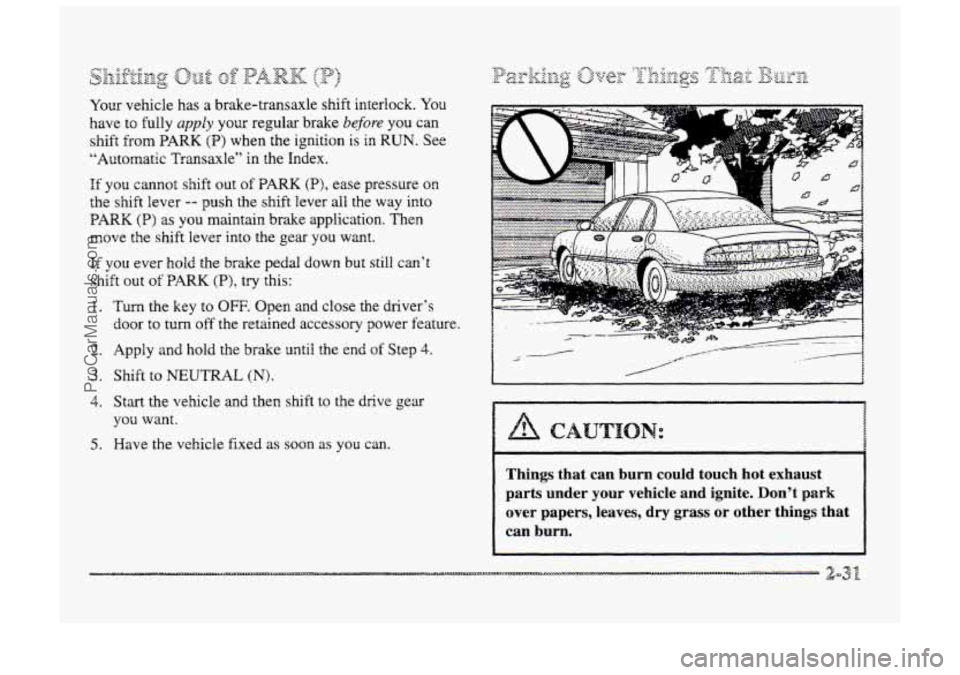
k;zgaA 'T:..:&pa: & LnP :V3;.,,t (.$ dL Bb* pFq- {p :.A AA &L \'& J
Your vehicle has a brake-transaxle shift interlock. You
have to fully apply your regular brake before you can
shift
from PARK (P) when the ignition is in RUN. See
"Automatic Transaxle" in the Index.
If you cannot shift out of PARK (PI, ease pressure on
the shift lever -- push the shift 'lever all the way into
PARK (PI as you maintain brake application. Then
move the shift lever into the gear
YOU want.
If you ever hold the brake pedal down but still can't
shift out of PARK (P), try this:
1.
2.
3.
4.
5.
Turn the key to OW. Open and close the driver's
door to turn
off the retained accessory power feature.
Apply
and hold the brake until the end of Step 4.
Shift to NEUTRAL (N).
Start the vehicle and then shift to the drive gear
you want.
Have the vehicle fixed as soon as you can. CAUTION:
Things that can burn could touch hot exhaust
parts under your vehicle and ignite. Don't park
over papers, leaves,
dry grass or other things that
can burn.
.. . .. 3 32 drn-2
ProCarManuals.com
Page 98 of 426
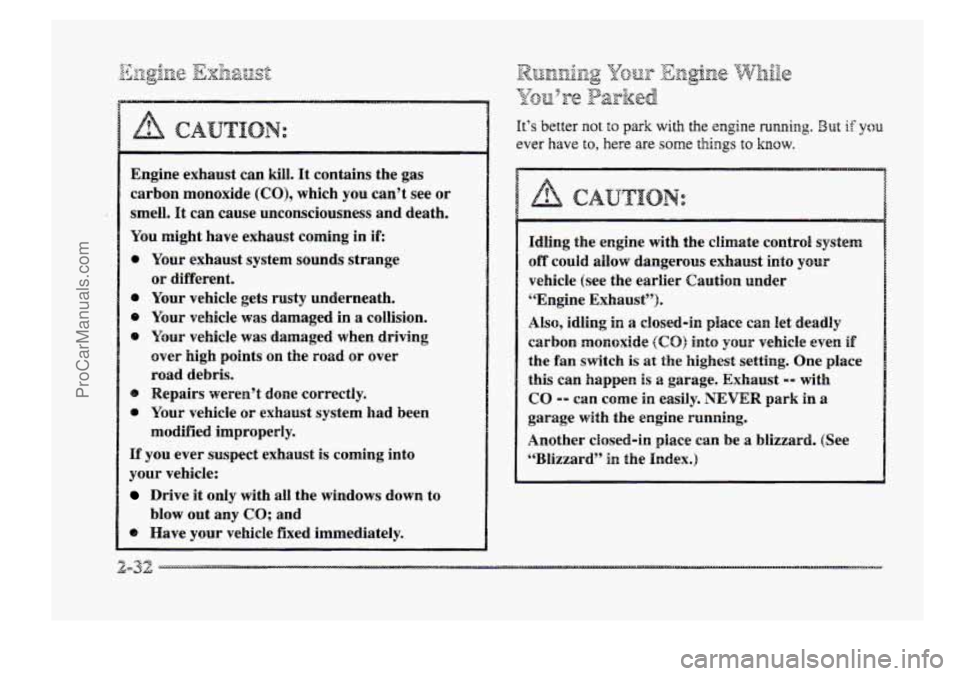
Engine exhaust can kill. It contains the gas
carbon monoxide
(CO), which you can’t see or
smell.
It can cause unconsciousness and death.
You might have exhaust coming in if:
0
0
e
Your exhaust system sounds strange
or different.
Your vehicle
gets rusty underneath.
Your vehicle was damaged in a collision.
YQUS vehicle was damaged when driving
over
high points on the road or over
road debris.
Repairs weren’t
done correctly.
Your vehicle or exhaust system had been
modified improperly.
If you ever suspect exhaust is coming into
your vehicle:
Drive it only with all the windows down to
Q Have your vehicle fixed immediately.
blow
out any CQ; and
It’s better not to park with the
engine running. 3118 if you
ever have to, here are some things to know.
Idling the engine with the climate control system
off could sallow dangerous exhaust into YOME-
vehicle (see the earlier Caution under
“Engine Exhaust”).
Also, idling in a closed-in place can let deadly
carbon
momxide (CO) into your vehicle even if
the fan switch is at the highest setting. One place
this can happen
is a garage. Exhaust -- with
CO -- can come in easily. NEVER park in a
garage with the engine running.
Another closed-in @ace can be
a blizzard. (See
“Blizzard”
in the Index.)
ProCarManuals.com
Page 99 of 426
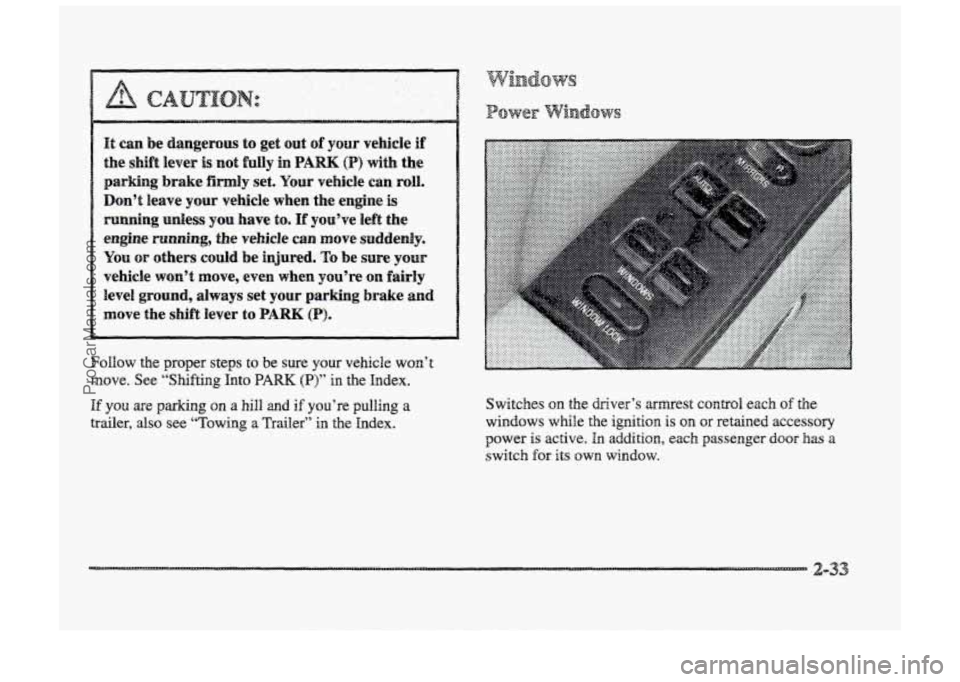
I& can be dangerous to get ut of your vehicle if
the shift lever is not fully in PARK (PI with the
parking brake firmly set. Your vehicle can roll.
Don’t leave your vehicle when the engine is
running unless you have to. If you’ve left the
engine mnnhg, the vehicle can BP~QV~ suddenly.
You or others could be injured. To be sure YOW
vehicle won’t move, even when you’re OEI fairly
level ground, always set your parking brake and
move the shift lever to PARK (PI.
H701Iow the proper steps to be sure your vehicle won’t
move. See “Shifting Into PARK (P)” in the Index.
If YOU are parking on a hill and if you’re pulling a
trailer, also see “Towing a Trailer” in the Index. Switches
on the driver’s
mest conltrol.each of the
windows while the
ignition is on or retained accessory
power
is active. In addition, each passenger door has a
switch for its own window.
2-33
ProCarManuals.com
Page 100 of 426
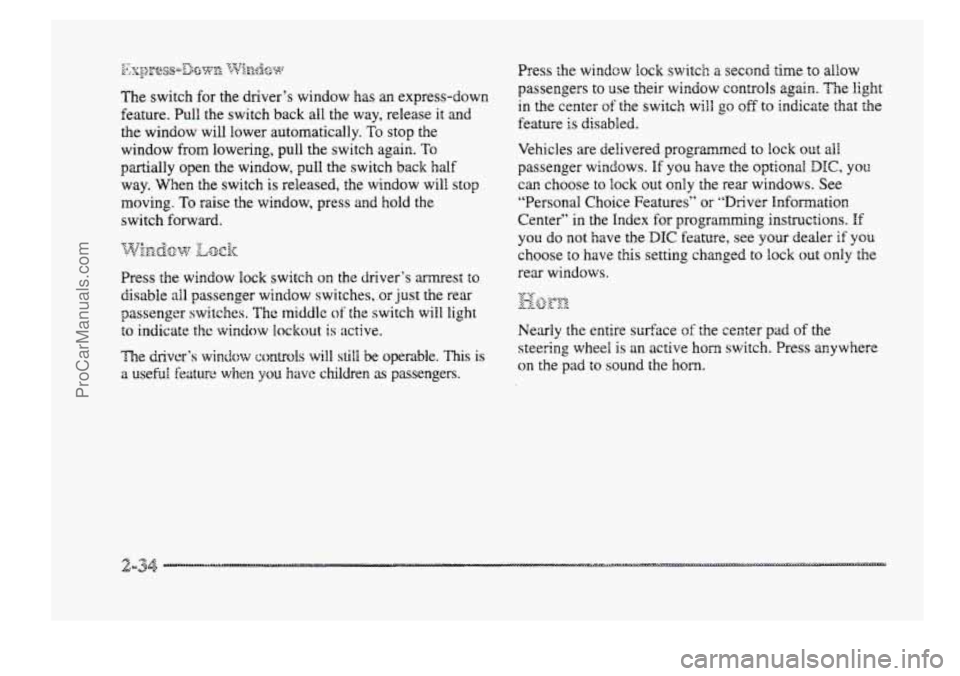
The switch for the driver’s window has an express-down
feature. Pull the switch back all the way, release it and
the window will lower automatically.
To stop the
window from lowering, pull the switch again. To
partially open the window, pull the switch back half
way. When the switch is released, the window will stop
moving.
To raise the window, press and hold the
switch
forward.
Press the window lock switch on the driver’s armrest to
disable dl passenger window switches,
or just the rear
passenger switches.
The middle of the switch will light
to indicate thc window lockout is active.
The diver’s window corat.rds will slill be operable. This is
a useful fwture when you have children as passengers.
Press the windcw lock switch a second time to ailow
passengers to use their window controls again. The light
in the center of the switch will go off to indicate that the
feature is disabled.
Vehicles are delivered programed
to Bock out all
passenger windows. If you have the optional DK, you
can choose
to lock out only the rea- windows. See
“Personal Choice Features” or “Driver Information
Center’’ in the Index for programming instructions.
If
you do not have the DIC feature, see your dealer if YOU
choose to have this setting changed to lock out only the
rear windows.
Nearly the entire surface
of the center pad of the
steering wheel is an active horn switch. Press anywhere
on the pad to sound the horn.
ProCarManuals.com